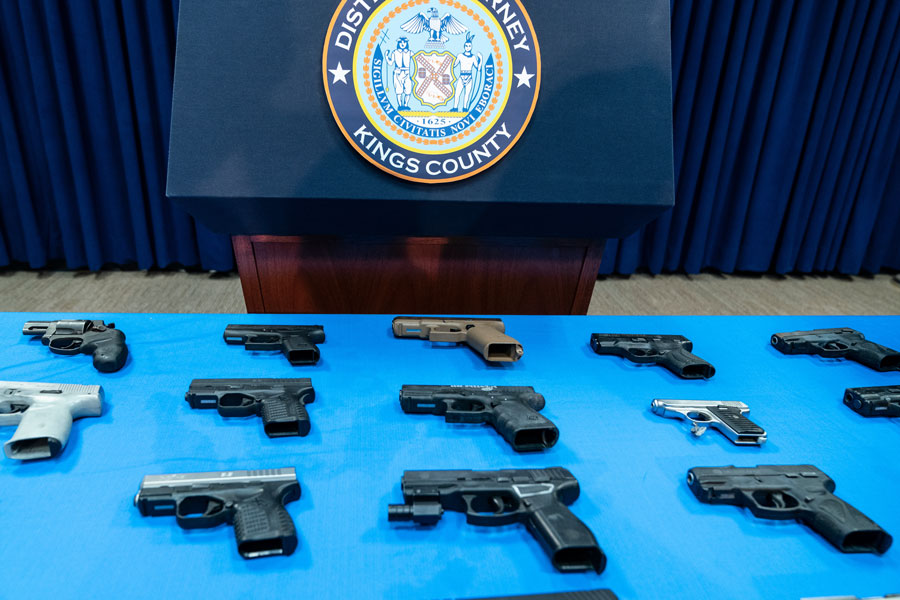
ALBANY, NY – State Police in New York have been experiencing an unusual problem—a lack of storage space for seized firearms. The loss of space can be attributed to the implementation of red-flag laws, designed to prevent individuals deemed as potential threats to themselves or others from possessing or purchasing firearms.
The massive influx of seized firearms paints a clear picture of the dramatic effects of these stringent laws in New York. According to the Washington Post, a surge in final orders under the law rose from 222 to over 4,300 in a span of just two years, with at least 1,800 firearms being confiscated by local law enforcement and state police in 2023 alone. These laws were not just invoked in instances of potential mass violence threats but have been utilized to mitigate a variety of imminent dangers.
New York’s aggressive approach to red-flags was ignited by an overwhelming increase in gun deaths nationwide and a devastating event—the Buffalo supermarket massacre of 2022. Following the tragedy, the state moved to modify its laws, thereby making red-flag orders a requirement rather than an option.
Despite the additional workload and infrastructural strain that these laws place on law enforcement officers, the state officials regard this situation as a positive indication. They assert that these minor growth pains symbolize the success of their strategy and its potential to prevent tragedies. In her annual address, New York Gov. Kathy Hochul (D) lauded the state’s gun-control legislation as a “model for the nation,” despite criticisms from gun rights groups who view the expanded use of the law as overzealous and unconstitutional.
Red-flag laws, also known as “extreme risk protection orders” (ERPOs), have now been adopted by 21 states. However, the success of these measures depends on their uniform application. For instance, towns like San Diego have implemented the law rigorously, while counties in states like Nevada and New Mexico lag behind with fewer than 30% employing such measures as per Everytown for Gun Safety’s research arm.
However, New York’s journey with the ERPO law has not been smooth sailing. Initially, the law was sparingly used by officials around the state. The horrifying massacre at Buffalo turned that tide significantly, transforming ERPO from an optional enforcement tool to an obligatory measure.
As part of strengthening the legislation, health care practitioners were added to the list of individuals eligible to file ERPO applications. This major shift marked New York’s determined stance towards curbing gun violence and enforced a clear obligation on authorities to act based on credible information about a potential threat.
This intensified implementation, however, faced initial challenges. State troopers were mandated to appear at court hearings on ERPO petitions without legal support. Gov. Hochul and New York Attorney General Letitia James soon rectified this by establishing a new unit of prosecutors dedicated to ERPO cases involving state police. This unit handled roughly 1,400 cases last year, claiming victory in more than 90% of them.
Despite the ongoing debates on the constitutionality of New York’s red-flag law and potential overreach, advocates like Allison Anderman, senior counsel at Giffords, argue that these laws have survived constitutional challenges across the nation. Simultaneously, some law enforcement personnel express concerns about the blanket application of this law. According to Timothy Dymond, the president of the New York State Police Investigators Association, some officers question the necessity of taking away individuals’ guns even though they are obliged to file an ERPO application. To such concerns, Dymond’s answer is firm and simple: “That’s the law.”
Sheriff Errol Toulon Jr. of Suffolk County emphasizes the life-saving impact of law enforcement actions. He cited an instance where a person made suicidal remarks last July, leading to a judge approving an ERPO. Subsequent investigation by the sheriff’s office uncovered the individual’s possession of 11 shotguns, 10 rifles, and 13 pistols.
In another case the following month, the police were alerted when an individual simulated putting a fake gun to their head, uttering, “wait until I get a real one.” Weeks later, the same person attempted to purchase a firearm but was thwarted because an ERPO had been sanctioned by a judge.
Whether the threat is directed towards oneself or others, Sheriff Toulon emphasized the importance of restricting access to firearms for those making such claims.
A scrutiny of recent and upcoming ERPO hearings in Suffolk County reveals cases primarily involving individuals deemed at risk of self-harm. However, there are instances where people pose a threat to others. For example, a 53-year-old man wielding an ax threatened to kill his brother and family, while a 42-year-old woman, experiencing paranoid delusions, discharged a shotgun at her ceiling and later carried the weapon to a nearby gas station. In both cases, firearms were confiscated. Despite 1,600 final ERPOs issued by judges in Suffolk County last year, the sheriff’s office seized fewer than 100 firearms. Chief Deputy Sheriff Chris Brockmeyer notes that in many instances, individuals may not own a gun, but the order prevents them from purchasing one for a year.


